What about the quality of BOSE's crossover network devices for their acoustimass sub-sat systems like "SE-5" (SE5) ?
And what is the aim of the lamps, that illuminate the interior of the chamber (have a look to the attached pictures) ?
Some people tell me, BOSE is claimed by their speaker demonstations, that only the best components available on the world market would be used in their speaker devices.
Because I don't know about the technology of the Bose crossover networks this above mentioned (for several readers stupid) questions.
Thank you for comments and advices.
And what is the aim of the lamps, that illuminate the interior of the chamber (have a look to the attached pictures) ?
Some people tell me, BOSE is claimed by their speaker demonstations, that only the best components available on the world market would be used in their speaker devices.
Because I don't know about the technology of the Bose crossover networks this above mentioned (for several readers stupid) questions.
Thank you for comments and advices.
Attachments
-
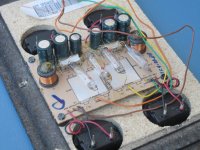 Bose Acousticmass SE-5 crossover.jpg152.4 KB · Views: 1,015
Bose Acousticmass SE-5 crossover.jpg152.4 KB · Views: 1,015 -
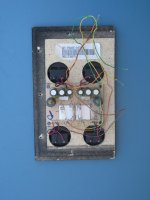 Bose Acousticmass SE5 mounting board.jpg119.4 KB · Views: 954
Bose Acousticmass SE5 mounting board.jpg119.4 KB · Views: 954 -
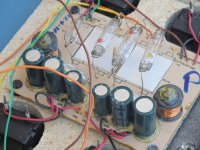 Bose Acousticmass SE-5 crossover+Lamps.jpg139 KB · Views: 963
Bose Acousticmass SE-5 crossover+Lamps.jpg139 KB · Views: 963 -
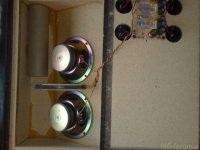 Bose acoustimass SE5 bass transducers.jpg57 KB · Views: 1,104
Bose acoustimass SE5 bass transducers.jpg57 KB · Views: 1,104 -
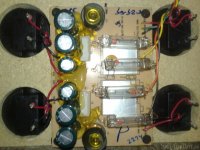 Bose acoustimass SE5 crossover.jpg72.5 KB · Views: 956
Bose acoustimass SE5 crossover.jpg72.5 KB · Views: 956 -
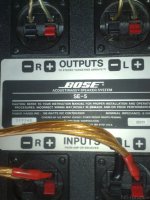 Bose acoustimass SE5 terminals.jpg362 KB · Views: 528
Bose acoustimass SE5 terminals.jpg362 KB · Views: 528 -
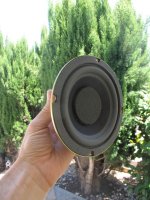 Bose Acoustimass SE-5 bass transducer front.jpg93.3 KB · Views: 434
Bose Acoustimass SE-5 bass transducer front.jpg93.3 KB · Views: 434 -
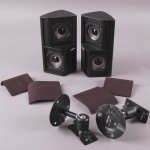 Bose Acoustimass SE-5 sat open.jpg58.1 KB · Views: 469
Bose Acoustimass SE-5 sat open.jpg58.1 KB · Views: 469 -
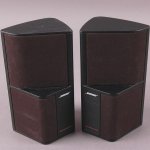 Bose Acoustimass SE-5 sat.jpg59.5 KB · Views: 376
Bose Acoustimass SE-5 sat.jpg59.5 KB · Views: 376 -
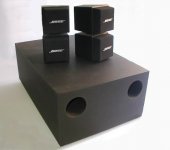 Bose SE-5 series I.jpg20.1 KB · Views: 330
Bose SE-5 series I.jpg20.1 KB · Views: 330
Last edited:
The lamps are a common trick for speaker protection. Their cold resistance is fairly low so they pass most of the signal. If you play too loud then they will heat up and their resistance will rise. This puts a soft limit on input signal.
Not real elegant but it works.
David S.
Not real elegant but it works.
David S.
"Some people tell me, BOSE is claimed by their speaker demonstations, that only the best components available on the world market would be used in their speaker devices."
Best??????? Try "components that cost us next to nothing with a HUGE markup for the consumer" Bose' strengths are their marketing ploys to convince people to pay way too much for what they get in return.
Best??????? Try "components that cost us next to nothing with a HUGE markup for the consumer" Bose' strengths are their marketing ploys to convince people to pay way too much for what they get in return.
the parts quality is pretty common for mass market, mass produced speakers.
Iron core inductors and electrolytic caps indicate that this item was built pretty much as cheaply as possible.
Without the lamps the speakers would fail pretty quickly so they are a good inclusion.
To improve the design one could substitute air core coils and film caps with the caps having the most influence on the sound quality.
Iron core inductors and electrolytic caps indicate that this item was built pretty much as cheaply as possible.
Without the lamps the speakers would fail pretty quickly so they are a good inclusion.
To improve the design one could substitute air core coils and film caps with the caps having the most influence on the sound quality.
they don't even use solder, LOL. They just wrap the wire around those little posts.
Properly done wire wrap is very secure.
I agree, I used to LOVE Bose equipment but I think after the 901 Series 3 they have started to ride their own coat tails.
I would expect higher quality from them but in the world of Hi-Fi they are not even in the top 100.
The Bose 901 Series' 1-3 could be plugged directly into a 110V outlet and produce an ungodly loud 60hz hummmmmmm.
Modern 901's will blow up.
There are a pair of 501's I have been eyeballing at the local pawn shop for $300.
I wonder if I pulled them apart, replaced the BP's with Polypropylene and the inductors with heavier gauge if they would be worth the investment?
I know I could build an awesome pair of speakers for $350 that would at least as good.
P.S. - Properly done wire wrap is GREAT, Poorly done wire wrap is a fire waiting to happen in certain situations.
I would expect higher quality from them but in the world of Hi-Fi they are not even in the top 100.
The Bose 901 Series' 1-3 could be plugged directly into a 110V outlet and produce an ungodly loud 60hz hummmmmmm.
Modern 901's will blow up.
There are a pair of 501's I have been eyeballing at the local pawn shop for $300.
I wonder if I pulled them apart, replaced the BP's with Polypropylene and the inductors with heavier gauge if they would be worth the investment?
I know I could build an awesome pair of speakers for $350 that would at least as good.
P.S. - Properly done wire wrap is GREAT, Poorly done wire wrap is a fire waiting to happen in certain situations.
Last edited:
Looks like rebuild time
I would replace the electrolytic capacitors with polypropylene since they last much longer. Generally the electros start to dry out after about 15 years but polys last much, much longer. Normally this is fine, the foam surrounds blow out about the same time as the electrolytics dry out so...
The inductors I would keep stock--spend the money elsewhere since no matter what you stuff in the crossover--it is still crossing too high in frequency to work properly. I believe the frequency is around 200 Hz or so.
The light bulbs as others have pointed out act as limiters--they burn off excessive voltage to protect the speakers. I had protection bulbs in a pair of JBL ProIII 5" woofer/1" tweeter small speakers about 20 years ago--the port tube would light up if I got too crazy.
The wire wound connections on the inputs is secure but they can develop corrosion after 10 to 20 years. Two options, either unwrap and resolder them or you can replace the input plates with 5 way binding posts if you like. That will give you a much more secure connection.
Had a buddy that inherited a set of those SE5's--he really didn't like the sound of the cubes so replaced them with 4 ohm JBL ProIII speakers. That caused the passive crossover to start tapering off the bass to the ProIII at 100 Hz instead of 200Hz stock settings due to the lower impedance. He stuffed the "bass module" between the two JBLs, adjusted his EQ a touch and liked the sound much better.
Good luck!
I would replace the electrolytic capacitors with polypropylene since they last much longer. Generally the electros start to dry out after about 15 years but polys last much, much longer. Normally this is fine, the foam surrounds blow out about the same time as the electrolytics dry out so...
The inductors I would keep stock--spend the money elsewhere since no matter what you stuff in the crossover--it is still crossing too high in frequency to work properly. I believe the frequency is around 200 Hz or so.
The light bulbs as others have pointed out act as limiters--they burn off excessive voltage to protect the speakers. I had protection bulbs in a pair of JBL ProIII 5" woofer/1" tweeter small speakers about 20 years ago--the port tube would light up if I got too crazy.
The wire wound connections on the inputs is secure but they can develop corrosion after 10 to 20 years. Two options, either unwrap and resolder them or you can replace the input plates with 5 way binding posts if you like. That will give you a much more secure connection.
Had a buddy that inherited a set of those SE5's--he really didn't like the sound of the cubes so replaced them with 4 ohm JBL ProIII speakers. That caused the passive crossover to start tapering off the bass to the ProIII at 100 Hz instead of 200Hz stock settings due to the lower impedance. He stuffed the "bass module" between the two JBLs, adjusted his EQ a touch and liked the sound much better.
Good luck!
The lamps are a common trick for speaker protection. Their cold resistance is fairly low so they pass most of the signal. If you play too loud then they will heat up and their resistance will rise. This puts a soft limit on input signal.
Not real elegant but it works.
David S.
Thanks Dave, I have not seen that before. Any downsides to doing this, its a great idea?
That Bose crossover certainly looks like it was built to a pricepoint. A low one. There may be more skill to that than is obvious.
The lamp in line is an old tweeter protection trick - in pro audio anyway. Don't think I've ever seen it before on anything but tweeters. You can buy the lamps at Parts Express. Eminence PX:BULB Replacement Crossover Fuse 290-659
Wasn't this an old radio operator's trick?
The lamp in line is an old tweeter protection trick - in pro audio anyway. Don't think I've ever seen it before on anything but tweeters. You can buy the lamps at Parts Express. Eminence PX:BULB Replacement Crossover Fuse 290-659
Wasn't this an old radio operator's trick?
Thanks Dave, I have not seen that before. Any downsides to doing this, its a great idea?
When I was at KEF and Laurie was very snooty about such things the arguement was that they weren't as good a match as our S-Stop was. S-Stop used a bridge rectifier and simple RMS log converter and RC time constant to create a varying voltage very well proportional to voice coil temperature for any input signal. When the voltage got to a certain level you tripped a relay that open circuited the drive until the temperature dropped.
I haven't directly played with the bulb solution but I know that you have to experiment to get the bulb characteristics and protection needs to be even roughly in line. I don't think the time constants match a tweeter, so you might over or under protect depending on how fast your power surge happens. As with all circuits you might have to overprotect for certainty or underprotect to take a risk but hopefully annoy the customer less. I also wonder about the consistency of bulbs in this application (testing would show).
Even with S-Stop, where we knew we were only protecting at the very threshold of driver damage, the customers where annoyed when a tweeter turned off to save itself. The better solution is always drivers that have greater power handling and don't need protection.
That is a real advantage of the bulb approach, that it ends up being a soft limiting effect and might not be noticed by most customers.
David
The lamp in line is an old tweeter protection trick - in pro audio anyway. Don't think I've ever seen it before on anything but tweeters. You can buy the lamps at Parts Express. Eminence PX:BULB Replacement Crossover Fuse 290-659
Wasn't this an old radio operator's trick?
I'm sure a lot of guys on the diy amp forum will tell you they fire up homebrew amps the first time with a 100 watt bulb in series. Both a series limiter and a fault indicator.
David
Looks like rebuild time
I would replace the electrolytic capacitors with polypropylene since they last much longer. Generally the electros start to dry out after about 15 years but polys last much, much longer. Normally this is fine, the foam surrounds blow out about the same time as the electrolytics dry out so...
The inductors I would keep stock--spend the money elsewhere since no matter what you stuff in the crossover--it is still crossing too high in frequency to work properly. I believe the frequency is around 200 Hz or so.
The light bulbs as others have pointed out act as limiters--they burn off excessive voltage to protect the speakers. I had protection bulbs in a pair of JBL ProIII 5" woofer/1" tweeter small speakers about 20 years ago--the port tube would light up if I got too crazy.
The wire wound connections on the inputs is secure but they can develop corrosion after 10 to 20 years. Two options, either unwrap and resolder them or you can replace the input plates with 5 way binding posts if you like. That will give you a much more secure connection.
Had a buddy that inherited a set of those SE5's--he really didn't like the sound of the cubes so replaced them with 4 ohm JBL ProIII speakers. That caused the passive crossover to start tapering off the bass to the ProIII at 100 Hz instead of 200Hz stock settings due to the lower impedance. He stuffed the "bass module" between the two JBLs, adjusted his EQ a touch and liked the sound much better.
Good luck!
You sir, Are suggesting the beating of a dead horse. Any money spent in "upgrading a bose product" would be better spent in producing a completely different product.
As an aside, I sometimes wonder if it would be a good idea to make a kind of modern clone of the Bose 901 using 9 affordable but nice enough fullrange speakers.
Lots have done it, including yours truly, but to end up with a system you can listen to, you have to spend more than you would to simply build a good quality set of speakers, and you haven't dealt with the EQ issue yet. Not sure you could build the 901 clone without it.
That is a real advantage of the bulb approach, that it ends up being a soft limiting effect and might not be noticed by most customers.
David
Back when I was making speakers in Thailand we had some compression driver failures in night clubs, which startled me since the driver should have been able to handle everything thrown at them, they were pretty robust. Then I noticed that the DJs were clipping the amps almost all the time and it dawned on me that this clipping would generate much higher frequencies and power dissipation in the tweeter than normal. Thats why we never saw a failure when they were driven and tested normally. The bulb might have been just the ticket.
I have never seen a failure for any speaker that was in a home.
When I was at KEF and Laurie was very snooty about such things the arguement was that they weren't as good a match as our S-Stop was. S-Stop used a bridge rectifier and simple RMS log converter and RC time constant to create a varying voltage very well proportional to voice coil temperature for any input signal. When the voltage got to a certain level you tripped a relay that open circuited the drive until the temperature dropped.
Were you at KEF in the early 1990s?
I ask because their car audio line Uni-Q came with a crossover had a bulb to protect the tweeter. You can see it in this pic, though it looks more like a fuse than a bulb.
An externally hosted image should be here but it was not working when we last tested it.
It was needed, too. I believe the KAR System 160Q used the same tweet as the then-current Reference-line Uni-Q, and it was a little fragile for car use. (Though I haven't blown mine, and I've had them since 1994. Then again, I've never blown any driver that wasn't a Jordan Module or JX53...)
- Status
- This old topic is closed. If you want to reopen this topic, contact a moderator using the "Report Post" button.
- Home
- Loudspeakers
- Multi-Way
- Bose Crossover Networks - Ultimate-/Reference- or only Average Quality Standard?